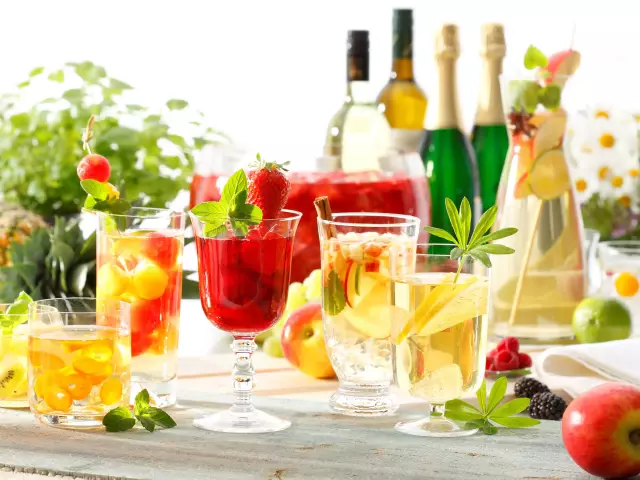Rosé
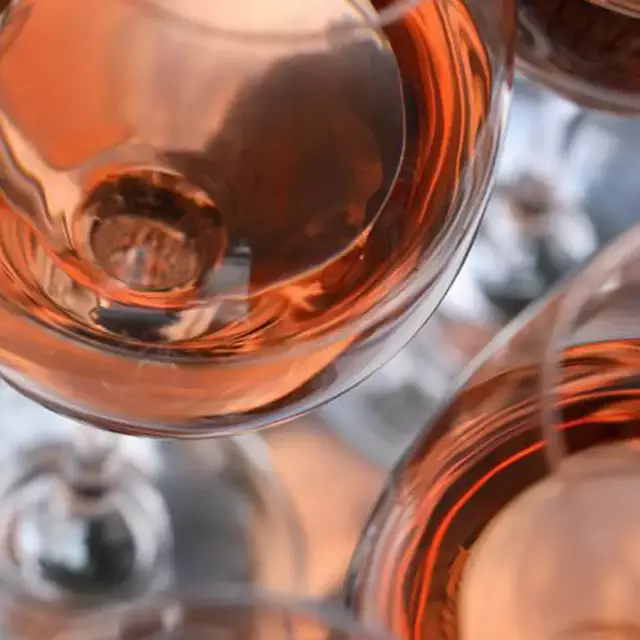
Over the last few years, the quality as well as the popularity of Rosé wine and Sekt has increased immensely. In 2020, Wines of Germany takes up this trend and showcase Rosé Wines.
Facts
-
12 %
is the share of rosé in the wines sold in Germany
-
9 - 13 °
are ideal drinking temperatures
-
2020
presented the DWI excellent rosé wines at ProWein
How is Rosé wine made?
In order to create Rosé, the red grapes are only lightly pressed initially. The so-called mash resulting from this light pressing is then left to rest for a while, to give the pigments in the grape skin time to colour the juice. Once the grape juice has taken on the desired shade of pink, the mash is pressed fully and the rosé-coloured juice is fermented into wine.
But not every rosé-coloured wine is called “Rosé”. Sometimes, you’ll find the term “Weißherbst” on the label. Since Weißherbst, as opposed to rosé, is always a single variety wine, the grape variety used in its production also has to be mentioned on the label. However, the term Rosé is more recognized internationally.
Varieties
Another rosé-coloured wine you might come across is Rotling. This is a special variety of rosé wine, produced by the joint pressing and fermentation of red and white wine grapes.
The so-called “Schillerwein” is a traditional Rotling from the wine-growing region Württemberg. No particular grape varieties are stipulated to produce Schillerwein.
Rosé wines are suitable companions at any time of the year. As a rule, they are served at a drinking temperature of 9-13 degrees centigrade, but during the warm summer months you might choose to cool them down even further, since they will warm up faster in higher ambient temperatures.
Enjoyment
Rosé and Weißherbst wines and their sparkling varieties make for a delightful aperitif or a companion for starters such as tapas and antipasti. We also recommend them with selected fish and barbecue dishes. Since they are naturally low in fruit acids and tannins, many wine lovers also enjoy having them with Asian specialities such as curries or Thai food. Also try mild, semi-hard cheeses such as Edam or young Gouda with delicately fresh and dry rosé-coloured wines: perfect harmony.
And, naturally, Rosé and Weißherbst wines are great partners for a fresh and fruity summer punch. Have a Pinot Noir Rosé together with strawberries and marvel at a combination that will not just tickle your taste buds but also please your sense of colour.
Which grape varieties make up "Badisch Rotgold" - a type of Rotling?
By definition: A "Badisch Rotgold" is composed of Pinot Gris and Pinot Noir and as the name suggests it comes from the Baden growing region.
Varietals

More recipe ideas
the classic with a difference Franconian cider soup
the classic with a difference
- 500 ml Weißwein (Spätlese)
- 500 ml Geflügelbrühe
- 350 ml Sahne
- 30 Gramm Zwiebeln
- 30 Gramm Weißes vom Lauch
- 30 Gramm Sellerie
- 30 Gramm Karotten
- 30 Gramm Butter
- 180 Gramm Mehl
- 2 Lorbeerblätter
- 1 EL Butterschmalz
- 4 Scheiben Weißbrot
- Nach Belieben Zucker, Muskat, Zimt, Salz
Sauté the vegetables in butter until lightly browned, dust with flour and then add the vegetable stock, wine and 250 ml cream. Add the spices and simmer for approx. 15 minutes.
Remove the crusts from the slices of white bread and cut into 1 cm cubes. Fry in hot clarified butter until golden brown and season with cinnamon, whip the remaining cream until stiff.
<p
<p> Strain the soup and flavour with nutmeg and salt.
Pour into deep plates, garnish with whipped cream and the cinnamon crusts.
- Müller-Thurgau (trocken)
- Silvaner (trocken)
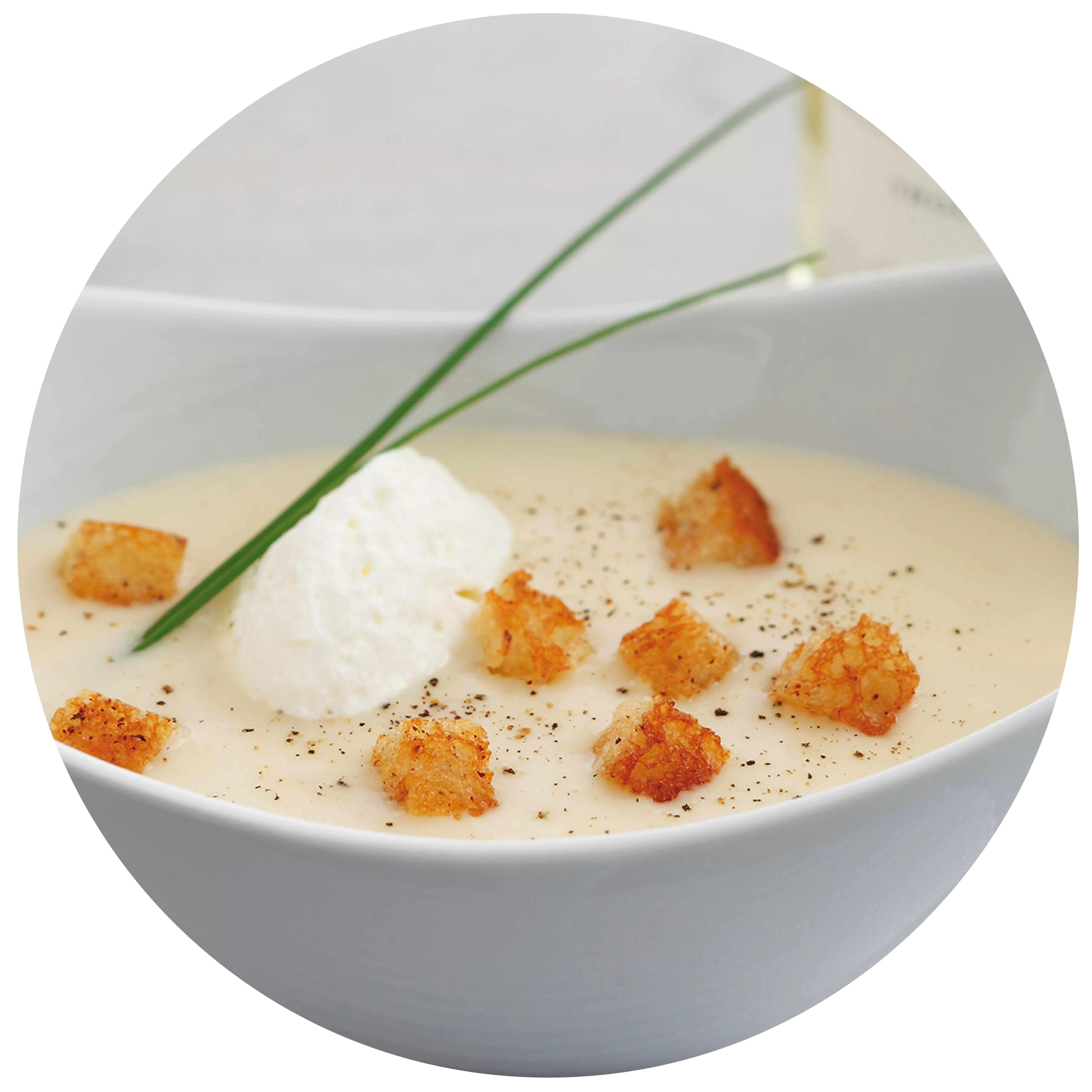
with ribbon noodles Coq au Riesling
with ribbon noodles
- 1 ganzes Huhn
- 0,4 Liter Riesling
- 0,2 Liter Sahne
- 1 kl. Glas Cognac
- 2 Stück Schalotten
- 1 Stück Knoblauchzehe
- 1 Stück Eigelb
- 1/2 Bund Petersilie
- 1 EL Mehl
- 50 Gramm Butter
- 1 EL Olivenöl
- nach Belieben Salz & Pfeffer
Carve the chicken. Heat approx. 50 g butter with 2 tbsp olive oil in a large frying pan and fry the chicken pieces until light brown (without the lid). Season lightly with salt.
Finely chop the shallots, peel and finely chop the garlic. Chop the parsley and add everything to the meat. Sauté briefly with the pan closed. Pour the cognac over the meat and light it (flambé). Deglaze with 1/3 litre of Riesling and leave to simmer for half an hour over a low heat. If necessary, add a little more wine and simmer for a further 10 minutes.
Remove the chicken pieces and keep warm for a short time. Mix 1 tbsp of flour with 1 egg yolk and the cream and whisk into the sauce. Flavour with salt and pepper. Return the chicken pieces to the pan. Serve immediately.
This goes well with tagliatelle.
Variant:Fry 150 g fresh mushrooms in 50 g butter and add.
- Riesling (trocken)
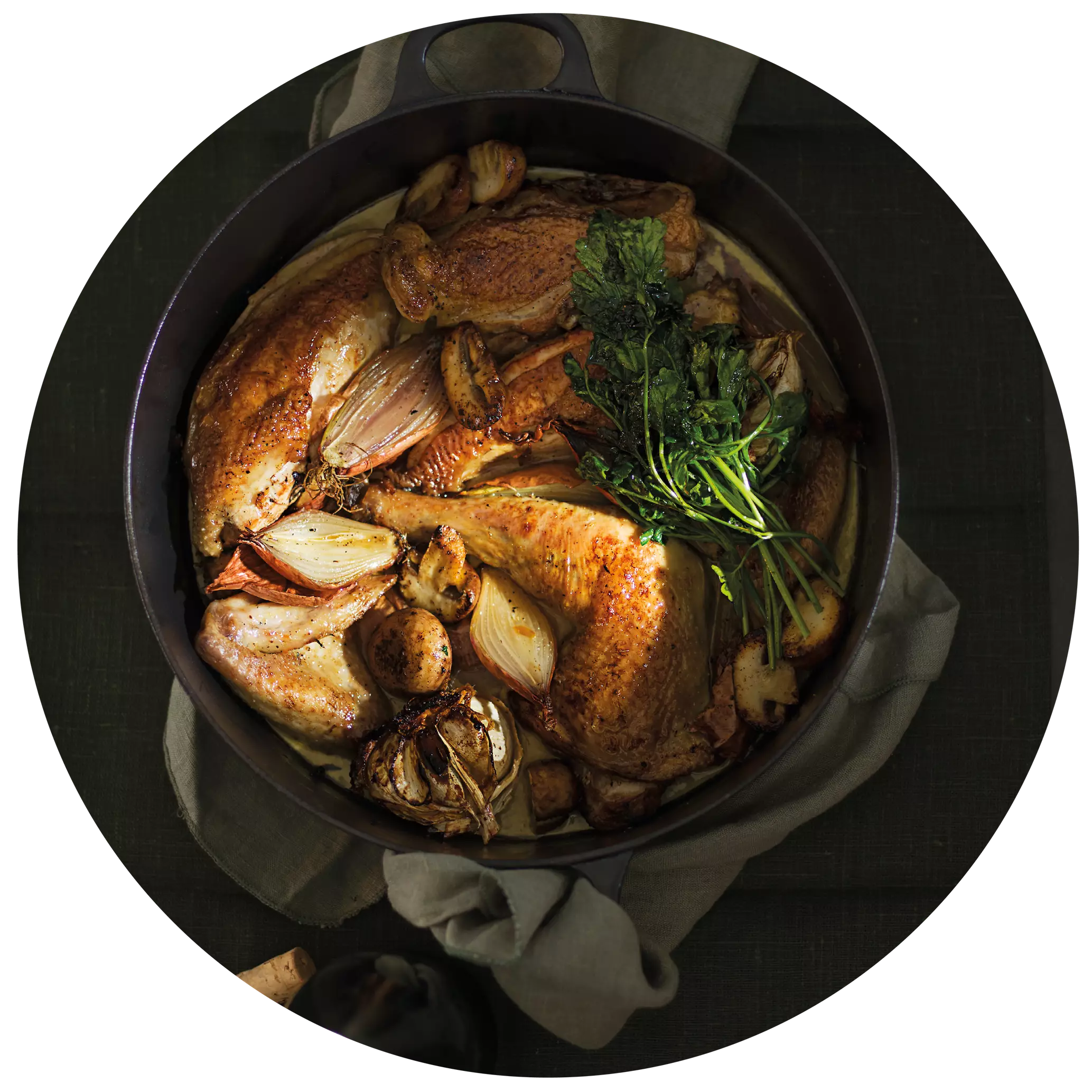
with apples Pork medallions
with apples
- 8 Stück Schweinemedaillons
- 500 Gramm Bandnudeln
- 2 große Äpfel
- 200 ml Sahne
- 10 Blättchen frischer Salbei
- 4 Zweige frischer Thymian
- nach Geschmack Zucker
- 3 EL Calvados
- 1 EL Öl
- zum Abschmecken Salz & Pfeffer
Slightly pepper and salt the medallions on both sides. Pluck the thyme, cut the sage into fine strips and roll the medallions in the herbs. Fry the meat in a pan with a little oil on both sides, not too hot, until it starts to colour. Remove from the pan and place on a preheated tray in the oven at 100 °C until cooked through.
Cook the tagliatelle al dente and keep warm.
In the meantime, peel the apples and cut into slices approx. 1.5 cm wide. Reheat the meat pan and add the apple slices. After about half a minute, sprinkle 1 teaspoon of sugar over the apples and allow them to caramelise. After a minute, deglaze the apple slices with a generous dash of Calvados and flambé. Add the cream and flavour with salt and pepper.
Remove the fillet from the oven. Add the meat juices from the oven dish to the sauce and serve the fillets with the tagliatelle, apple slices and Calvados apple sauce.
<p- Riesling (trocken)
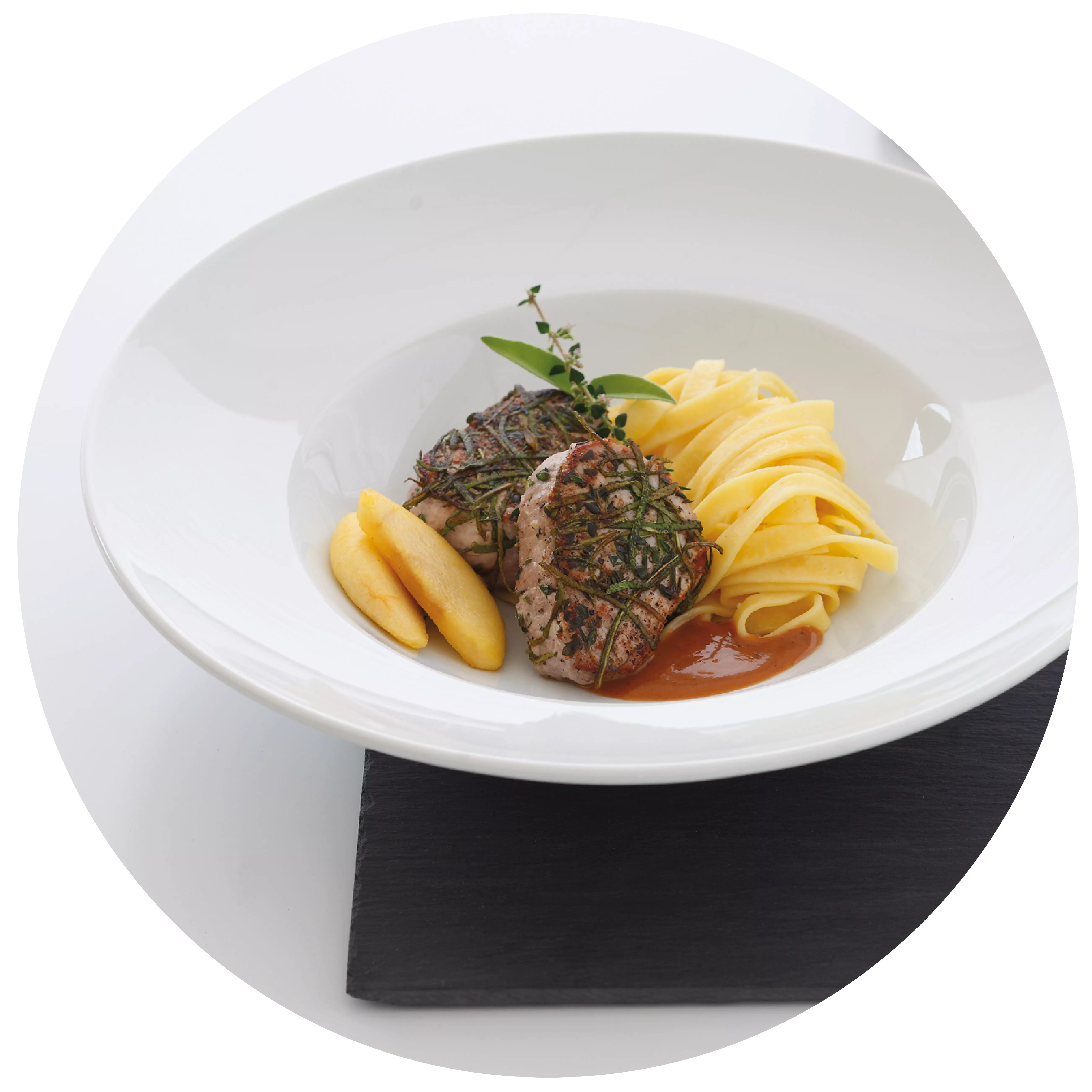
Japanese hollandaise succeeds with wasabi paste Salmon with Japanese hollandaise and green asparagus
Combine salmon with hollandaise and asparagus with a dry Riesling.
- 4x 150g Lachsfilet mit Haut
- 1 Limette
- 2 Zehen Knoblauch
- 4 EL Honig
- 10 EL Sojasauce
- 200g Butter
- 4 Eier
- 1 EL Joghurt
- 2 EL Reisessig
- 2 EL Wasabipaste
- 500 g Grüner Spargel
For the marinade, finely chop the garlic first. Wash the lime in hot water, grate the zest and squeeze out the juice and bring everything to the boil with the honey and soya sauce. Put to one side.
Now prepare the Japanese hollandaise: Bring 180g butter to the boil. Place the egg yolks, yoghurt, rice vinegar, wasabi paste and a pinch of salt in a tall measuring jug and mix with a hand blender. Gradually mix the boiling (!) butter into the egg yolks using a hand blender. Season the hollandaise with salt and pepper to taste and keep the measuring jug warm in hot water.
Peel the bottom third of 500 g green asparagus and cut off the ends. Melt 1 tbsp butter in a large pan. Add the asparagus to the pan, pour in 50 ml water and season with salt and pepper. Cover and bring to the boil briefly.
Fry the salmon fillets on the skin side in a little oil for about 4 minutes. Turn the salmon and fry for a further 2 minutes. Then turn again and baste with the marinade. Remove the salmon from the pan and reduce the marinade until thick. Brush the salmon with it. Serve the salmon with the hollandaise and asparagus. Enjoy your meal!
Wine recommendation:
WINE TIP: Dry Rielsing
- Riesling (trocken)
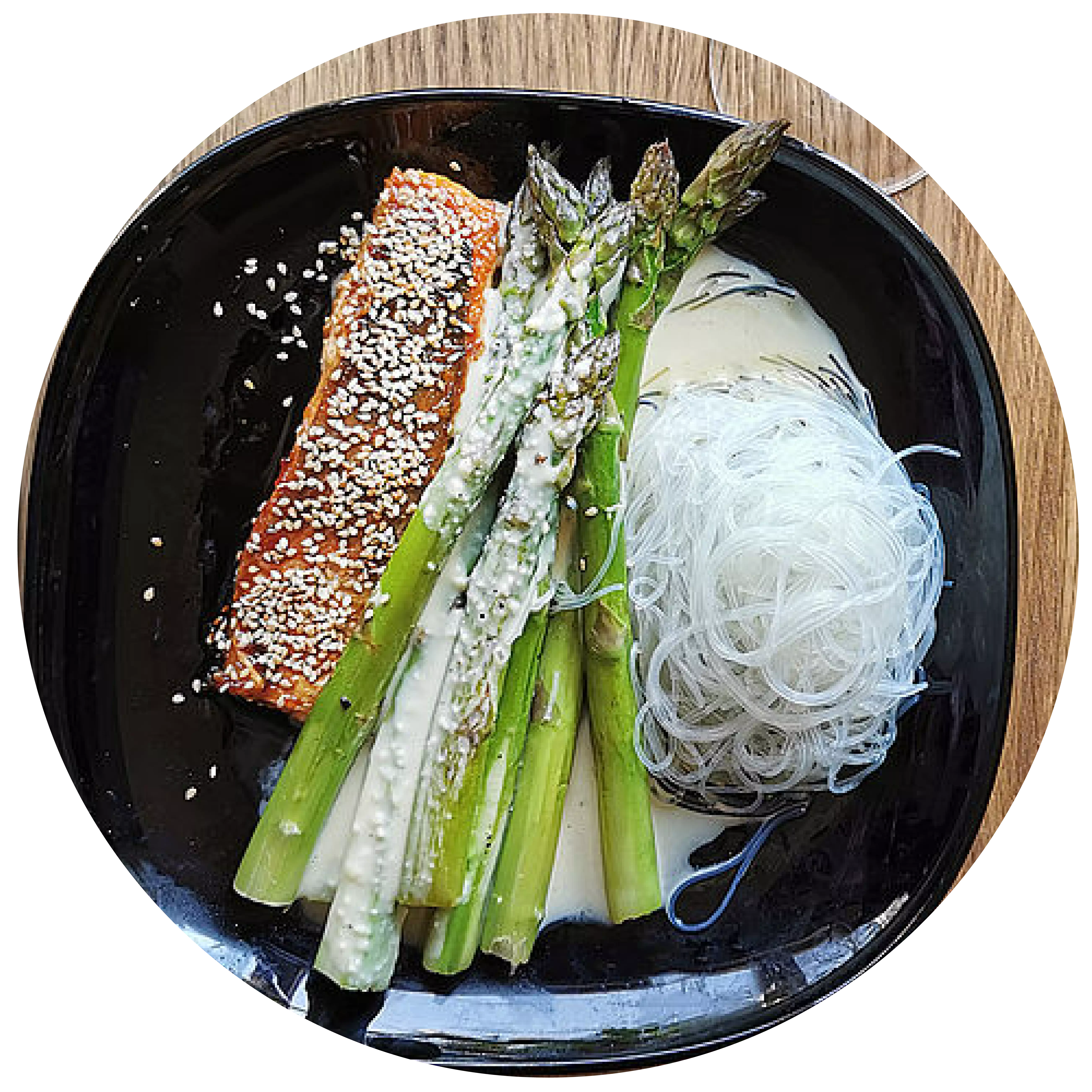
Events
-
Show
winetasting in our winery - blind tasting
Mainz-Hechtsheim




